Understanding RC LiPo Battery Ratings
What Do All Those Numbers Mean?
by John Salt Last Updated August 2024
The LiPo Battery Ratings label that comes on most, if not all RC LiPo packs looks very confusing at first glance. I know I didn't have a clue what all those numbers meant when I got my first electric power RC helicopter after years of flying nitro, or if they were even that important to understand. Turns out they are very important!
The 4 main rating numbers you will see most often on RC LiPo battery labels are:
- Voltage
- Capacity
- Charge Rate
- Discharge Rate
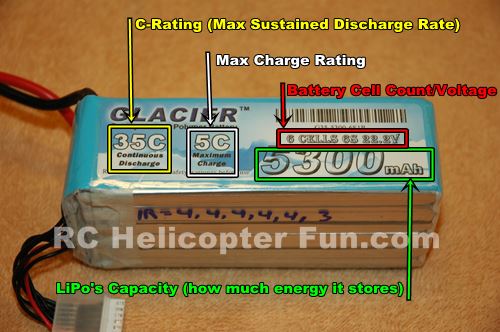 The 4 Primary Rating Numbers Shown On Most RC LiPo Packs
The 4 Primary Rating Numbers Shown On Most RC LiPo Packs1. LiPo Nominal Voltage & Cell Count
What is Nominal Voltage?
Nominal voltage is usually referred to as the "resting voltage" of the battery cell or battery pack.
Nominal resting voltage is an industry standard (agreed convention) that varies for all battery chemistry types; but for our standard RC LiPo chemistry, the usual nominal voltage is 3.70 volts per cell.
That voltage however is not the fully charged voltage of the cell (which is as high as 4.2V), nor is it the 50% storage voltage (apx. 3.85V), or even the 80% discharged state resting voltage (apx. 3.74V).
Nominal voltage numbers often confuse folks and I get a fair number of related questions. To keep things simple, just think of 3.70 volts as the guide number used to determine the voltage value you see printed on the LiPo battery pack sticker.
Other than the smallest of electric RC models, RC LiPo battery packs will have at least two or more cells hooked up in series to provide higher voltages. For larger RC models that number can be as high as 12 cells and more, pushing 50+ volts.
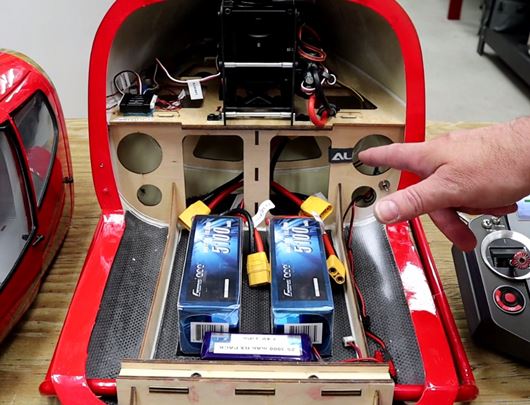 12S Powered. Two 6S LiPo's in series are used in this 800 size scale RC helicopter providing about 50 volts when fully charged.
12S Powered. Two 6S LiPo's in series are used in this 800 size scale RC helicopter providing about 50 volts when fully charged.Here's a list of LiPo RC battery pack "nominal" voltages with cell counts. Again, this is usually the voltage number printed on the battery rating label.
If you're wondering what the 1-14S in parenthesis means; it's the way battery manufacturers indicate how my cells hooked in series (S) the battery pack contains. Fully charged voltage of the packs is the number in green.
- 3.7 volt battery = 1 cell x 3.7 volts (1S) 4.2V
- 7.4 volt battery = 2 cells x 3.7 volts (2S) 8.4V
- 11.1 volt battery = 3 cells x 3.7 volts (3S) 12.6V
- 14.8 volt battery = 4 cells x 3.7 volts (4S) 16.8V
- 18.5 volt battery = 5 cells x 3.7 volts (5S) 21.0V
- 22.2 volt battery = 6 cells x 3.7 volts (6S) 25.2V
- 29.6 volt battery = 8 cells x 3.7 volts (8S) 33.6V
- 37.0 volt battery = 10 cells x 3.7 volts (10S) 42.0V
- 44.4 volt battery = 12 cells x 3.7 volts (12S) 50.4V
- 51.8 volt battery = 14 cells x 3.7 volts (14S) 58.8V
I should point out you may run across packs or cells hooked up in parallel to increase the capacity. This is indicated by a number followed by a "P". Example: 2S2P would indicate two, two celled series packs hooked up in parallel to double the capacity.
So, those are the voltages you need to know and each RC model or more specifically, the motor/speed controller combination will indicate what voltage is required for correct operation/RPM.
This number has to be followed to the letter in most cases since a change in voltage equates to a change in motor RPM and will require changing the gearing but more likely the motor to a higher or lower KV rating - not something I want to get into in this write-up (I cover it in my setup & tips eBook). If a model calls for a 3 cell (3S) 11.1 volt battery – let's just say that is what has to be used.
2. LiPo Battery Capacity Rating
Capacity indicates how much energy the battery pack can hold and is indicated in milliamp hours (mAh), at least on our smaller RC packs. This is just the standard way of saying how much load or drain (measured in milliamps) you can put on your battery for 1 hour at which time the battery will be fully discharged.
For example an RC LiPo battery that has a rated capacity of 1000 mAh would be completely discharged in one hour with a 1000 milliamp load placed on it.
If this same battery had a 500 milliamp load placed on it, it would take 2 hours to drain down. If the load was increased to around 15,000 milliamps (15 Amps); a common current drain in a 3S powered 450 sized RC helicopter while gently hovering - the time to drain the battery would be only about 4 minutes.
Note, as the discharge rate increases, the capacity of a battery actually becomes less than stated due to internal resistance efficiency & other losses; but in our discussion here, we are keeping things simple and "linear" :-)
As you can imagine for an RC model helicopter with that kind of current draw, it would be very advantageous to use a larger capacity battery pack such as a 2000 mAh pack. This larger pack used with a 15 amp draw would double the hover time to about 8 minutes.
In other words, if you want more flight time; increase the capacity of your battery pack.
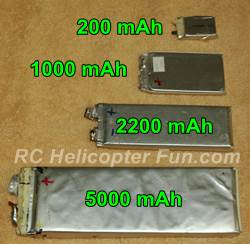 RC LiPo Battery Capacity Cell Size Comparison
RC LiPo Battery Capacity Cell Size ComparisonUnlike voltage, capacity can be changed to give you more or less flight time.
Naturally because of size & weight restrictions, you have to stay within a certain battery capacity range in your model seeing that the more capacity a battery pack has, the larger and heavier it will be.
Think of increasing the RC Lipo battery capacity similar to putting a larger fuel tank in the RC vehicle.
3. LiPo Maximum Charge Rating
This is the highest charge current the manufacturer states in their LiPo battery ratings that the battery can be safely charged at. It is however not the charge rating for best battery life!
A 5C charge rate as shown on our example LiPo battery ratings label, would mean you can safely charge that battery at 5 times its capacity. With our 5300 mAh pack example in that photo, the calculation is 5 x 5300 mA = 26,500 mA or a 26.5 Amp charge rate.
Please note however, charging at maximum rates will shorten battery life. Again, this is a safe maximum number, not a best for maximum life number.
Lower charge rates of 1C (or lower) are always best for maximizing LiPo battery life!
4. LiPo Battery Maximum Discharge Rating (C Rating)
This one is probably the single most over-rated, manipulated and misunderstood of all battery ratings.
Discharge Rate (also called the discharge C Rate) is the maximum current (how fast) a battery can be discharged safely while not overheating or off-gassing (puffing up).
The unfortunate truth is this number is almost always overstated by most LiPo Battery manufacturers. Sometimes by a lot! There is no way to regulate it as there are many ways to come up with a C number and manipulate it under idyllic or unrealistic test methods.
Not only that, the maximum safe discharge rate is a moving target that will fluctuate depending on several factors including pack temperature, age and internal resistance (more on this in a bit).
Remember that ion exchange thing we covered back on the RC LiPo Battery Page? Well the faster the ions can flow from anode to cathode in a battery will lower the internal resistance and thus increase the maximum safe discharge rate.
How To Use The C Rating Number.
A battery with a discharge rating of 30C would mean you could theoretically safely discharge it at a rate 30 times the capacity of the pack.
Using our 1000 mAh battery as an example; if it has a 30C discharge rating, that would mean you could pull a maximum sustained load of 30 x 1000 milliamps = 30,000 mA or 30 Amps.
From a purely theoretical time stand point (not taking the 80% discharge rule into account), this equals 500 mAh of draw per minute, so the 1000 mAh pack would be completely exhausted in about 2 minutes if it's exposed to that maximum rated 30C (30A) discharge rate the entire time.
Calculation: 1000mAh divided by 30,000 mA = 0.033 hours x 60 minutes = 2.0 minutes).
Most RC LiPo Battery packs will show the continuous C rating and sometimes a maximum burst C rating. A burst rating indicates the battery discharge rate for short bursts (a few seconds maximum) of extended power. An example might be something like "Discharge rate = 40C Continuous / 80C Bursts".
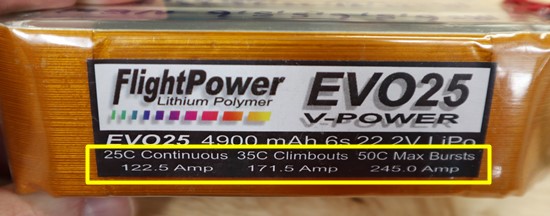 LiPo Pack With 3 Discharge Ratings
LiPo Pack With 3 Discharge RatingsYou don't see this often, but the LiPo pack pictured above actually indicates three different discharge C rates, along with the sustained discharge current underneath each one. As usual, these numbers were overly ambitious and the real safe discharge rate was 25% to 50% less than indicated on the pack.
Calculating A Realistic Safe Discharge C Rating Using Internal Resistance
So how do you know what the safe discharge rating a LiPo pack really is if it's almost always overstated by the manufactures? You can use this simple formula:

You multiply the maximum cell IR (internal resistance) in a pack by the capacity of the pack, take the square root of that number, and then divide the number into 2500. The resulting number is the safe sustained C rating you can realistically pull from the battery.
It's not ideal because the IR is a moving target, but it's the best method I have found yet and certainly gets you in the ball park.
I cover this IR calculation formula in much more detail and exactly how to do it and what to watch out for on my Internal Resistance Page, but I wanted to mention it here while going over these often misleading C ratings.
Using Pack Temperature To Gauge Discharge C Rating
An easier, albeit less accurate C rating determination method is by simply taking a temperature reading of your packs or just holding/feeling them after running them to gauge if you're using a high enough C rating.
The general rule I was told is if you can't comfortably hold a LiPo pack tightly in your hand after using it, it's way too hot! This equates to anything higher than about 60C (140F).
Even that is too warm as far as I'm concerned. Nothing higher than 50C (about 120F) is what I consider safe and I rarely have my packs go much past 40C (100F) unless it's also very hot outside as well. Some of my larger LiPo packs are over 12 years old now with little degradation following this temperature advice; anecdotally, I know this works well.
Leaving your packs in the car on a hot sunny day can certainly heat them up well past 40C as well. Internal or external heat - both have the same negative effect, hot LiPo's are miserable and they won't last long.
What C Rating To Get?
The higher the C rating, usually the more expensive and slightly heavier the battery gets. This is where you can perhaps save some money, and maybe even a little weight.
Getting an extremely high discharge C rated pack when there is no way you could possibly pull the full amount of power is not required but it certainly won't hurt either.
The most important thing is you can't go with too low a discharge C rating or you will damage your battery and possibly your ESC (electronic speed control).
Just like the maximum charge number, the maximum discharge number is what the manufacturer deems is safely possible, but not what will give you the best life and as we know, these C rating numbers are almost always overstated.
The other important thing to keep in mind is the maximum safe discharge C rating of any LiPo battery, regardless of what is printed on the label is highest when the pack is new and is in a constant state of decline as you use your LiPo battery.
So how do you know what C rating to get when purchasing your LiPo RC Battery Pack/s?
The easy answer most will give is to get the largest C rating you can afford from a LiPo brand you trust.
If money is not an object I agree with that almost 100%. The higher the C rating, the cooler the pack should run, and the longer it should therefor last as was covered on the RC LiPo Page in the discharge section.
However, you could also be tossing your money away if the manufacturer grossly overstates the C rating (anything over 100C I basically see as nonsensical) in order to charge a premium price. You might for example be able to get LiPo packs with half the C rating (even less it it's realistic) for half the price and they would be more than adequate.
Recommended Discharge Ratings For Different Helicopters
As a very general guideline and knowing how most LiPo manufacturers overstate the true C rating, 30C to 40C discharge rated packs are the norm for most 150-550 size electric helicopters with general to sport flying in mind.
For larger birds, 40C to 60C discharge rated packs are a safe bet (again for normal to sport). Once up to aggressive 3D, that is where the 60C and up discharge rated packs come into play.
My own anecdotal experiences over the past decade + are if you get a LiPo pack with a C discharge rating at least double of the maximum you intend to pull out of it; that should give you enough discharge current with room to spare if the manufacturer is overly optimistic with their C rating. It also gives you room to spare as the pack ages and the discharge C rating decreases.
As an example, suppose your helicopter uses a motor and ESC both rated at a maximum of 100 Amps, and it uses a 5000 mAh (5 Ah) battery. What C rating should be considered using my double method?
100 Amps / 5 Amps = 20C. Double that = 40C.
If you fly really aggressively however, I would recommend going triple the C rating (60C) or higher.
It of course totally depends on how accurate or how misleading the LiPo manufacturer is with their claimed C rating. Again, use this an estimate guide only.
Last of our LiPo Battery Ratings: Watt Hours
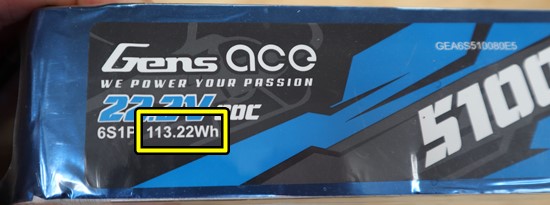 LiPo Battery Watt Hour Rating - Why?
LiPo Battery Watt Hour Rating - Why?Thought I better mention the Watt Hour (Wh) rating that you will sometimes run across on LiPo battery ratings as shown above.
I really don't see much value in this specific LiPo rating in the world of RC flying; I find Amp hours much more useful & practial, but that is just me. Wh are however easily calculated it if it's not stated on the LiPo pack and you find it a useful rating.
Watt hours are determined by multiplying the nominal voltage x the capacity; so on this GensAce pack, 5100 mAh x 22.2V = 113,220 mWh = 113.22 Wh.
Keep in mind that is the calculated power output over time. In the real world, the number is lower due to internal resistance of the pack and the fact the voltage will decay as the battery drains.
By the way, LiPo internal resistance is another important pack rating that I personally find very useful. It's never listed on the LiPo battery ratings, but it's a very important number to monitor in my opinion.
That pretty much sums up all those RC LiPo battery rating numbers. Out of the 5 covered, the two main ones you must understand are the voltage/cell count and the capacity since they dictate what settings you use on your RC charger to charge the packs as demonstrated in the video below.









